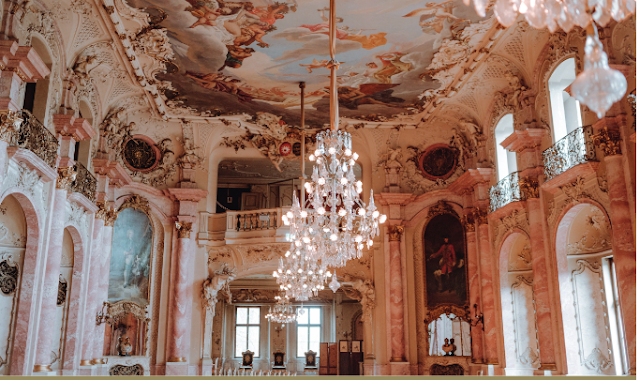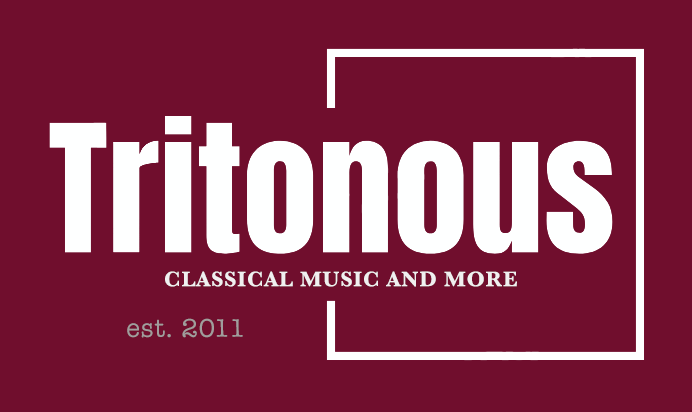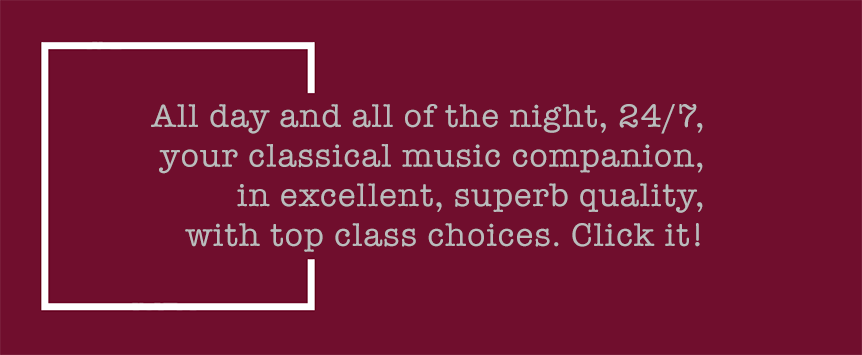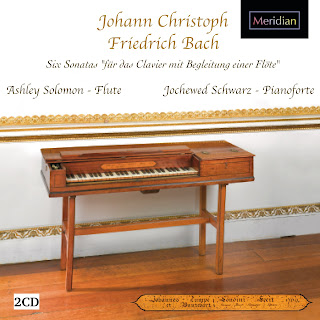Johann Christoph Friedrich: Six Sonatas “für das Clavier mit Begleitung einer Flöte oder Violine”; Ashley Solomon, Jochewed Schwarz; Meridian Records
Reviewed 20 January 2025
With a poised fluidity and an imagination hovering between Baroque and Classical, JCF Bach’s music proves well worth exploring on this disc of his sonatas for keyboard and flute, add to this the seductive timbre of the period square piano
Born in Leipzig in 1732, Johann Christoph Friedrich Bach was JS Bach’s fifth son (coming between CPE Bach and JC Bach). He was described by Wilhelm Friedemann Bach as the strongest harpsichordist amongst the brothers and at the age of 17 became harpsichordist to Count Friedrich Wilhelm Ernst zu Schaumberg Lippe and for the next 45 years, until his death, JCF Bach was resident in Bückeburg in Lower Saxony, the capital of the tiny principality of Schaumburg-Lippe. Count Friedrich Wilhelm was eight years older than his new employee and the grandson of King George I of England (via one of the king’s illegitimate daughters).
Schaumburg-Lippe was the smallest state in the Holy Roman Empire, and the Count was educated and musically literate, playing the clavier and probably the flute. Whilst his father’s court had employed just one musician (!), Count Friedrich Wilhelm employed fifteen (including JCF Bach), including recruiting Italian musicians. JCF Bach took over as concertmaster in 1756 when the Italian musicians returned home.
The majority of JCF Bach’s music remained in manuscript, and was the property of the Count, probably written for the Count’s musical circle. Unfortunately the majority of this was lost in the Second World War. Thankfully, JCF Bach did publish a small selection of his music, and flute is a regular feature of his published music, and in 1777 he published Six Sonatas intended for keyboard with flute or violin. There are six of these and they have been recorded by flautist Ashley Solomon and keyboard player Jochewed Schwarz for Meridian.
This new recording does not just give us a chance to hear JCF Bach’s six sonatas, but to do so on instruments that he might have recognised. Ashley Solomon plays a flute made in 2005 and modelled on on by Carlo Palanca from around 1750. Jochewed Schwarz plays not on a harpsichord but on a square piano by Johannes Zumpe and Gabriel Buntebart made in London in 1769 and currently in the Cobbe Collection at Hatchlands Park where the recording was made.
German instrument maker Johannes Zumpe came to London around 1750 and worked with harpsichord-maker Burkat Shudi before establishing his own workshop. Zumpe’s speciality was small, square pianos, a simpler version of the piano hammer mechanism that had been invented in 1710. These were low-price, convenient instruments and they combined a modest amplitude of sound with some harpsichord overtones.
 |
| Schloss Bückeburg, home of JCF Bach’s employer, Count Friedrich Wilhelm |
In 1778, the year after Count Friedrich Wilhelm died, JCF Bach was given permission to travel to London to visit his brother JC Bach. Here, JCF Bach was introduced not only to the new classical style but most probably to these new pianos. It is known that JCF Bach bought an English piano, most likely a Zumpe square piano, to take home to Germany.
There are six sonatas, each with three movements. Apart from the first sonata, all are in major keys and have a minuet as the third movement, whilst three have a polonaise as the second movement. The first sonata, the only one in a minor key, has a second movement which, fascinatingly, alternates between the melodic flute sections, with keyboard accompaniment, and recitatives for solo keyboard, for all the world like a movement from a vocal cantata.
There is a freedom and fluidity to the music and often it is akin to instrumental pieces by JCF Bach’s brother, CPE Bach, and like CPE Bach, JCF Bach is a somewhat transitional figure. That his employer was fond of Italian music is perhaps reflected in aspects of these sonatas. They are engaging, fluid pieces and definitely not negligible.
Despite their title, the sonatas are most definitely not accompanied sonatas, the flute and keyboard are equal partners, complementing each other and intertwining. Sometimes it is the flute that introduces the ideas, and the ornaments in the two parts differ, thus giving performers scope for improvisation and freedom.
A word about the keyboard, because its sound is what hit me first when I started listen to these discs. There is a distinct percussive quality to the sound, and my first analogy would be to the cimbalom, the hammer dulcimer, which is perhaps not that far away. What the keyboard does is provide strong harmonic support for the flute, there is a clarity to the harmonic texture which does not always happen with a harpsichord. Also, there is a lovely contrast between the fluid flute and the more struck timbre of the keyboard. In Jochewed Schwarz’s hands, the keyboard sound has a nice range of colours and subtlety, complementing Ashley Solomon’s sophisticated playing.
This disc gives us a small glimpse into a forgotten, and largely lost, musical world. JCF Bach is somewhat undeservedly squashed between his brothers, but this disc shows his music well worth exploring.
Johann Christoph Friedrich Bach (1732-1795) – Six Sonatas “für das Clavier mit Begleitung einer Flöte oder Violine”
Ashley Solomon (Baroque flute)
Jochewed Schwarz (square piano)
Recorded, February 2023, The Cobbe Collection Trust, Hatchlands PArk, East Clandon, Surrey
MERIDIAN CDE84679 2CDs [51:50, 50:50]
The blog is free, but I’d be delighted if you were to show your appreciation by buying me a coffee.
Elsewhere on this blog
- ‘They are all gone now, and there isn’t anything more the sea can do to me’: Riders to the Sea – interview
- A glorious, yet sophisticated noise: Handel’s Solomon from Paul McCreesh & Gabrieli with Tim Mead – concert review
- A highly effective synthesis: James Joyce’s The Dead in a dramatised reading from Niamh Cusack with music from The Fourth Choir – review
- Creating a personal world: Ethel Smyth’s earliest orchestral work alongside new pieces by inti figgis-vizueta & Ying Wang – record review
- The complete Walton songs: there aren’t that many but Siân Dicker, Kyrstal Tunnicliffe, Saki Kato certainly make us understand why they are all worthy of attention – record review
- The idea of Greece: Robin Tritschler and Jonathan Ware in a wide-ranging recital from Schubert, Loewe & Wolf to Shostakovich, Dvorak, Berkeley & Ravel – concert review
- Uprising! Director Sinéad O’Neill on Glyndebourne’s new community opera written by Jonathan Dove and April De Angelis – feature
- Drawing us in: baritone James Atkinson makes his Wigmore Hall debut with pianist Iain Burnside in a programme moving from Robert to Clara Schumann to Brahms’ late tombeau for Clara – concert review
- New Year in Berlin: taking new Torsten Rasch, Beethoven’s Choral Symphony, Mendelssohn’s Paulus & artists of Circus Roncalli – concert review
- Home








